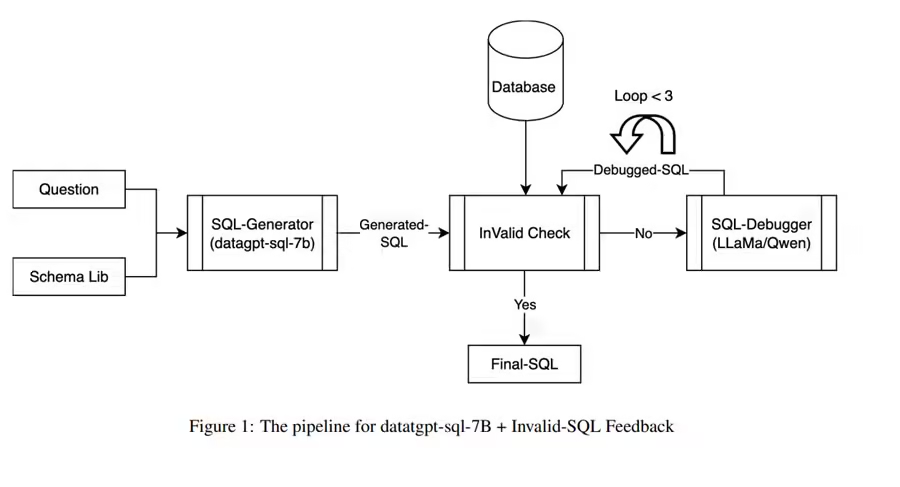Table of Contents
ToggleA team of researchers from Cainiao Network has released DataGpt-SQL-7B, a new open-source language model designed to transform natural language questions into SQL (Structured Query Language) queries. With its ability to democratize access to databases, DataGpt-SQL-7B is set to empower non-expert users, allowing them to extract and analyze data without needing to understand the technicalities of SQL.
The model, introduced in a paper published in September 2024, demonstrates a significant leap forward in the field of Text to SQL conversion. With an accuracy rate of 87.2% on the Spider development benchmark, DataGpt-SQL-7B marks a substantial improvement over previous models. But what does this mean for everyday users and the future of data access? Let’s take a closer look.
The Problem: Bridging the Gap Between Natural Language and SQL
Databases have become an integral part of almost every modern organization, yet querying these databases is still a challenge for most non-technical users. Typically, querying requires knowledge of SQL, a specialized programming language designed for managing and retrieving data from databases. The technical barrier often prevents non-experts from interacting with the data, despite their need to access and interpret it.
Text to SQL systems aim to solve this problem by allowing users to express their data needs in natural language, such as asking, "How many customers purchased a product last month?" The system then translates this question into an SQL query that retrieves the relevant data from the database.
However, existing models, particularly large language models (LLMs) like GPT-4, come with their own set of limitations, such as high computational costs, privacy concerns, and a reliance on proprietary technology. This is where DataGpt-SQL-7B steps in.
What is DataGpt-SQL-7B?
According to the research paper, DataGpt-SQL-7B is a compact, fine-tuned model specifically designed to tackle Text to SQL tasks. By focusing on this specific domain, the model delivers better performance while avoiding the high costs and risks associated with closed-source LLMs.
One of the standout features of this new model is its integration of schema linking—a method that helps the model align natural language queries with the correct table and column names in a database. This has long been a challenge in the Text to SQL domain, and DataGpt-SQL-7B’s innovation here is its use of cross-DataBase and Inner-DataBase methods for training. These methods significantly improve the model’s ability to identify the appropriate schema and generate correct SQL queries.
In addition to schema linking, the model employs Direct Preference Optimization (DPO), which fine-tunes the model to ensure that the SQL queries it generates are executable and syntactically correct. To achieve this, the system leverages a self-refinement mechanism, where incorrect SQL queries are automatically debugged and corrected based on feedback from the database.
Methodology: Fine-Tuning for Perfection
The development of DataGpt-SQL-7B involved the creation of a specialized dataset of over 20,000 Text to SQL samples. This dataset was then used to fine-tune a language model called CodeQwen1.5-7B-Chat, which already had a strong foundation in code generation.
The team introduced two primary data augmentation techniques:
- Cross-DB Augmentation: This method enhances schema selection by allowing the model to learn from multiple databases with similar schemas.
- Inner-DB Augmentation: This focuses on refining the model’s ability to choose the correct columns within a single database, adding or removing tables and columns during training to simulate real-world conditions.

These techniques allow DataGpt-SQL-7B to better understand the structure of different databases and generate accurate SQL queries across various scenarios. In fact, the research shows that these methods improved the model's performance on the Spider benchmark, a well-regarded dataset used to evaluate Text to SQL models.
Experimental Results: A New Benchmark in Accuracy
The results are impressive. The researchers tested DataGpt-SQL-7B on the Spider benchmark, where it achieved an execution accuracy (EX) of 87.2% and a test-suite accuracy (TS) of 83.5%. These scores are higher than other models, including GPT-4, which managed only 72.9% in EX and 64.9% in TS.
The EX metric measures how often the generated SQL queries produce the correct output when executed on a database, while TS accuracy evaluates whether the SQL passes multiple database test cases, ensuring consistency.
One of the key innovations contributing to this performance is the incorporation of invalid SQL feedback. The model can recognize when it has generated an incorrect SQL query, debug it using an integrated SQL-Debugger, and refine the output until it aligns with the correct result.
Summary of the Research
| Problem | Methodology | Result | Conclusion |
|---|---|---|---|
| Translating natural language to SQL | Fine-tuned model using Cross-DB and Inner-DB augmentation; DPO for accuracy | Achieved 87.2% EX and 83.5% TS on Spider benchmark | DataGpt-SQL-7B offers a robust, open-source solution for Text to SQL tasks, outperforming other models |
Key Takeaways from the Research
- Compact and Open-Source: Unlike closed-source LLMs like GPT-4, DataGpt-SQL-7B is an open-source model, making it accessible for organizations concerned about privacy and high costs.
- High Accuracy: With an EX score of 87.2%, the model sets a new benchmark in the Text to SQL domain.
- Self-Refining: The integration of invalid SQL feedback allows the system to automatically debug and refine its outputs, improving reliability.
- Efficient Schema Linking: The cross-DB and inner-DB augmentation methods enhance the model’s ability to correctly identify table and column names, a common issue in SQL generation.
- Scalable Solution: The system is designed to handle complex queries and can scale to different database environments with ease.
Conclusion: Democratizing Data Access
The introduction of DataGpt-SQL-7B represents a significant leap forward in making databases more accessible to a broader range of users. By removing the need for SQL expertise, this model empowers non-technical individuals to retrieve and analyze data simply by asking questions in natural language.
Not only does this have the potential to enhance productivity within organizations, but it also reduces the risk associated with closed-source, expensive language models. The future of data querying looks promising, with models like DataGpt-SQL-7B paving the way for more efficient, user-friendly solutions.
Final Thoughts
DataGpt-SQL-7B is more than just an academic achievement, it is a tool that could redefine how businesses and individuals interact with databases. The open-source nature of the model ensures that it can be widely adopted, improving access to data without the need for specialized knowledge.
With further development and fine-tuning, this model could become a staple in industries where data-driven decision-making is critical. As organizations look for more inclusive and cost-effective ways to handle their data, the innovations behind DataGpt-SQL-7B are poised to make a lasting impact.
